 Royal Navy – 23 ships converted, service 1951-1977
Royal Navy – 23 ships converted, service 1951-1977HMS Rapid, Relentless, Rocket, Roebuck, Troubridge, Grenville, Ulster, Ulysses, Undaunted, Undine, Urania, Urchin, Ursa, Venus, Verulam, Vigilant, Virago, Volage, Wakeful, Whirlwind, Wizard, Wrangler, Zest
We open the ball here on cold war Royal Navy Frigates with the case of WW2 destroyer “recycling”: The Type 15 and 16 ASW Frigates. The goal here was to made complete or partial rebuilt of WW2 destroyers which became surplus after WW2, whereas the RN was in need for faster ASW escorts, even than the River/Loch/Bay classes. One solution was to capitalized on the existing speed of destroyer, having them repurposed for their new mission. In total, 23 anti-submarine frigates emerged from the 1942 standard War Emergency Programme “utility” design, obsolete in 1945. This was due to the discovering of the new Type XXVI submarines, which rendered most Royal Navy escorts obsolete overnight, a technology known into production by the Soviet Navy with the mass-produced Whiskey-class submarine.
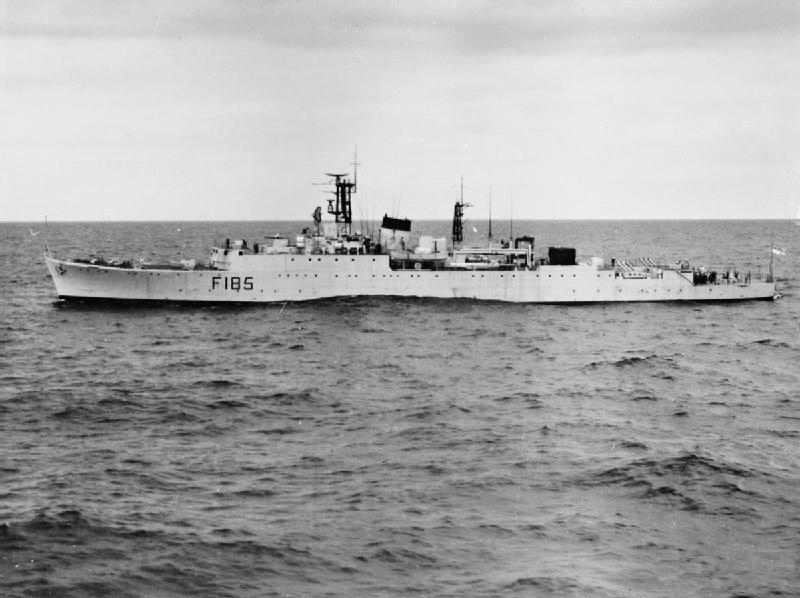
HMS Relentless
Development
This conversion was studied, found practicable, and estimated much cheaper than new, dedicated escorts in these postwar budget-stricken years. The urgent need of fast frigates to counter the new generation of fast Soviet ‘Whiskey’ class submarines indeed could most readily be met by adapting the numerous “Emergency” destroyer hulls. By the late 1940s they were now totally unsuited to modern warfare, as the majority had low-angle guns and primitive fire control. Accordingly, in 1949 plans were drawn up to convert two prototypes, Rocket and Relentless.
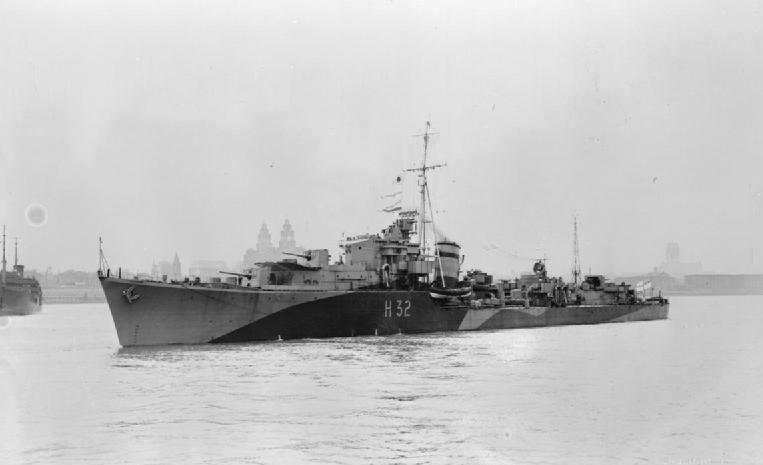
HMS Rapid (H53), standard War Emergency Programme “utility” design in February 1943, chosen as lead ship for the conversion.
It should be added that before them, the RN already started working on the Type 11 Frigate, a 1945 concept of 25 knots steam-powered hull called ’25 kts sloops” and designed in two variants, one AA and one ASW escort, later AD in February 1946. No trace survived of most work done on these, especially the Type 11 ASW variant. The whole project was dropped as soon was known the construction of the Whiskey (Project 613) submarines.
The change ported to the emergency destroyers, most of which were laid down in 1941-42, completed in 1943-44, was dramatic, with a new forecastle deck extending almost to the stern and a superstructure of riveted aluminium. A new type of enclosed bridge was provided at the forward end of the superstructure, directly ahead of the Operations Room, mainly in order to be close to the latter, but also to provide protection from the weather. The captain was provided with a periscope to permit him to con the ship from the Ops Room and even the lookouts were given transparent plastic domes in the bridge wings.
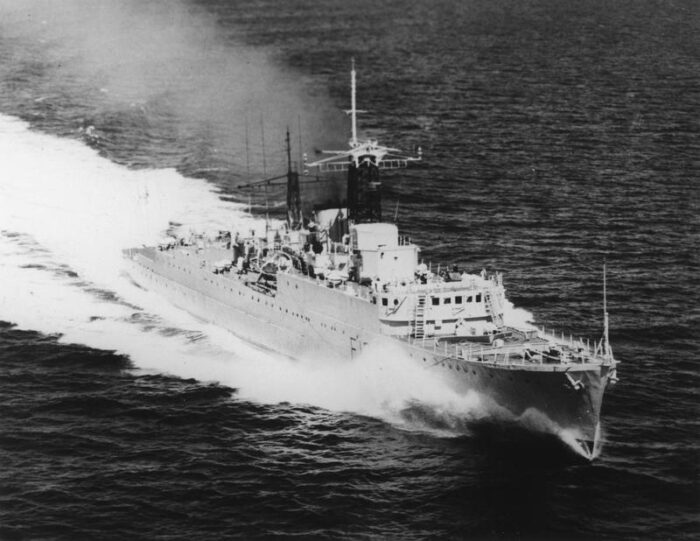
The armament was light a twin 4in Mk.16 with its own CRBEF director aft and a twin Bofors above the bridge — but the ASW armament was nearly on a par with the as yet unbuilt Type 12, consisting of search and attack sonars of the latest type and two Squid mortars aft (replaced by an ASW mortar Mk.10 in later ships); HMS Rocket and Relentless had the Mk.10 prototype. It was hoped to supplement this with eight 21-inches ASW homing torpedoes, but the failure of the “Bidder” Mk.20 (14) torpedo caused the tubes to be removed from the few ships so fitted.
This Type 15 conversion ranks as one of the great successes of postwar years, making useful for 25 more years numerous hulls that should have been scrapped otherwise. Even in that guise they were considered too costly as a conversion, and the Type 16 that followed were made for half the budget and called partial conversions, as the ten ships of the Type 16 or Tenacious class, but they were never as effective. The Type 15 proved weatherly and robust, and became an excellent interim escort as the postwar concept of ASW frigate was going through rapid doctrinal changes and delayed budgets, aborted projects and change of policy. The end of this long process was the Whitby class, but they arrived from 1958 onwards. So in the meantime, the RN had to make due with 33 converted destroyers and Loch/Bay/River class vessels that were now obsolete despite upgrades. The appearance of the 1960 Soviet SSNs such as the November class capable of 31 knots+ only aggravated the issue.
Numerous changes were made: The endurance was reduced to 470 nm at 15 kts with 476t fuel oil. Conversions were spread up between many yards to keep them busy, first conversions being completed in 1952 and last in 1954. The core of the modifications was their new enclosed bridge, above the ops. room, and three had their 40 mm AA guns relocated. Wrangler was the only one resold to the South African Navy. Others ended in the RCN and RAN. In their latter years, in the 1970s, even 1980s for some, they were used for training or special purpose, and two were converted with helicopter platform to study their behaviour with these at sea and landing, taking off operation in rough weather on small ships to see if it was practicable.
Construction:
Yards known to have been involved are: Portsmnouth DYd 1950-52, Verulam 1952, Troubridge (completed by White, 1955-57); Devonport DYd Rocket 1950 52, Roebuck 1952-53, Ulysses 1952-53, Venus 1953, Wizard 1954; Chatham DYd – Ulster 1952-53, Zest 1954-56; Grenville 1953-54, Virago 1952; Scotts – Wakeful 1952-53; Palmers – Whirlwind 1952-53, Ursa 1952-54; Harland & Wolff, Belfast Wrangler 1951-52; Harland & Wolff, Liverpool – Urania 1953-54; White Volage 1952, Undaunted 1952-54; Barclay Curle – Urchin 1952-54; Stephens Rapid 1952-53; Thornycroft. Vigilant 1952; Yarrow Undine 1954. The main modification was to provide a new enclosed bridge above the ops room and in three of the ships (Troubridge, Ulster, Zest) the 40mm mounting was resited in an embrasure at the forward end of main deck.
Influence:
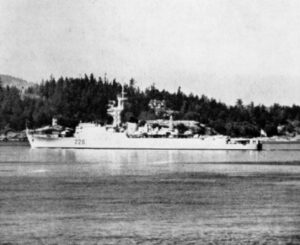 The solution to an interim ASW frigate before the new Type 12 and 14 could be completed, laid in these now redundant 47 War Emergency Programme destroyers remaining in the inventory, only a few years old but seeing little service as no longer relevant, consuming maintenance and crews. The conversion plan “post-whiskey” called for “fast anti-submarine frigates” incorporating wartime experience in the design, concretised in 33 vessels total, including 23 fully converted (Type 15 “1st-rate anti-submarine frigates”) and ten on budget as Type 16 “austere” or 2nd class ASW frigates.
The solution to an interim ASW frigate before the new Type 12 and 14 could be completed, laid in these now redundant 47 War Emergency Programme destroyers remaining in the inventory, only a few years old but seeing little service as no longer relevant, consuming maintenance and crews. The conversion plan “post-whiskey” called for “fast anti-submarine frigates” incorporating wartime experience in the design, concretised in 33 vessels total, including 23 fully converted (Type 15 “1st-rate anti-submarine frigates”) and ten on budget as Type 16 “austere” or 2nd class ASW frigates.
HMCS Algonquin, HMCS Crescent and HMCS Crusader were converted the same way for the Royal Canadian Navy.
Four RAN Q-class destroyers (HMAS Quadrant Queenborough Quiberon Quickmatch) were also converted as Type 15 frigates from 1953–57 for the RAN, whereas the remaining HMAS Quality was scrapped in 1958.
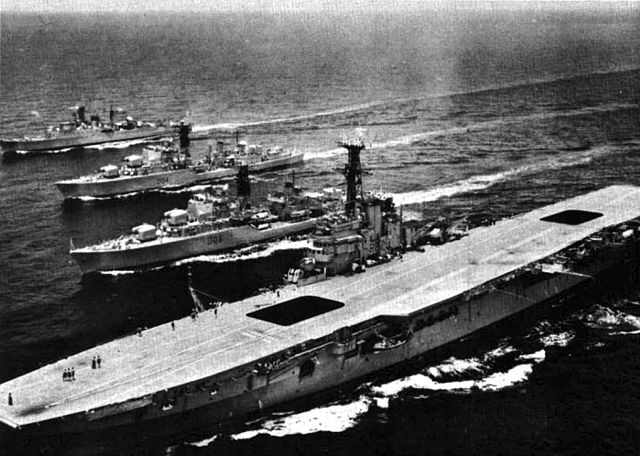
HMAS Melbourne escorted by two Tobruk class DDs and an Australian Type 15 Frigate (background)
The South African Navy which also reveiced former destroyers had three rerconversions: Jan van Riebeeck (ex-Wessex) Simon van der Stel (ex-Whelp) and Vrystaat (ex-Wrangler).
This inspired also the US Navy, which faced the same problems, albeit with a more generous budget, and followed suit in 1960–65 with the “FRAM” program, seeing the conversion of Fletcher, Allen M. Sumner and Gearing-class destroyers. They too, were an interim before the arrival of the mass-built Knox-class frigates and Spruance-class destroyers in 1969.
HMS Wakeful and HMS Troubridge were used in the 1965 cold-war drama “The Bedford Incident” as “USS Bedford” to impersonate an US Farragut-class destroyer, while interior shots were filmed in Troubridge.
Design of the class
Hull and general design
The conversion was a really thorough process. After this, the former DDs were just unrecoignisable. While in Yards, all the superstructure, weaponry, masts and equipments were removed. In drydock, the machinery was extracted, and completely overhauled. The forecastle was now extended aft, leaving only a small quarterdeck, for extra accommodation, a constant critique for large wartime crews. The new single-level superstructure encompassed now a fully enclosed bridge, new concept for an escort ship with double glass and wipers, as well as an operations room just behing, and sonar room fillwing the whole width of the hull forward of the new single funnel left.
This new superstructure layout somewhat inspired by what the Canadian designed as well at the time, allowed the crew to fight inside the ship without having to expose themselves to the elements. This became handy as well as NBC protection could be implemented. These ships also received new lattice masts to carry a new breed of radars and HF/DF antennae as well as extra communications equipment. HMS Troubridge, Ulster and Zest were the first fitted with the new design of bridge later adopted on all frigates until the Leander class. This bridge had angled sides, raked windows for good all-round vision without internal reflections at night.
As completed, these ships ended susprisingly heavier, not lighter than the original destroyers, which had torpedp rube sand masked 120 mm main guns as well as more developed superstructures. They displaced 2300 long tonnes standard (2,337 t) whereas an R class displaced 1,692 long tons (1,719 t) and 2,411 long tons (2,450 t) full load versus 2,700 long tons (2,743 t) full load for the Type 15 after conversion. This was partly due to fuller structures and heavier masts, radars, sonars and equipments, such as the heavy ASW grenades used by the Squid/Limbo systems.
Powerplant
It was completely overhauled, but not changed in nature. These steam-driven plants were well known and reliable to bring the necessary top speed to deal with the fastest Soviet submarines in the Atlantic despite heavy weather. They kept their two shafts arrangements, propeller, their two steam turbines fed by two Admiralty 3-drum boilers. This powerplant was rated originally for 40,000 shp (30 MW) and regained the same figures after a compehensive overhaul: The boilers were scrapped anew, all the piping was changed, the heaters and blowers as well and the tubines were carefully dismounted, all rotors blades were inspected, blades repaired or changed, both in the high pressure and low pressure stages. Thus, the Type 15 regained all their performances, being still capable of hitting 31 knots (57 km/h; 36 mph) even when fully loaded, whereas the original destroyers were capable of 36 knots nominal. However their range was lowered from 4,675 nmi (8,658 km) at 20 knots (37 km/h) to perhaps 4200 nm at 15 knots.
Armament
A completely new armament was installed to go with new sensors. They had mostly a defensive armament with a twin Mark 19 DP guns turret forward on the new structure and a pair of Bofors while the main ASw armament was at the poop with two ASW rocket launchers. Squid at first, as the ships were being completed, then Limbo Mark 10.
It had been intended as well to carry the new anti-submarine Mark 20E torpedoes. A wtin tube on each beam, four total, would have dispensed them. The tubes where fitted to be later removed when the programm, a complete failure, was cancelled. HMS Rapid, Roebuck and the V-W-class had Squids for budgetary measures, not the better Limbo.
4-in (102 mm) Mark 19 gun
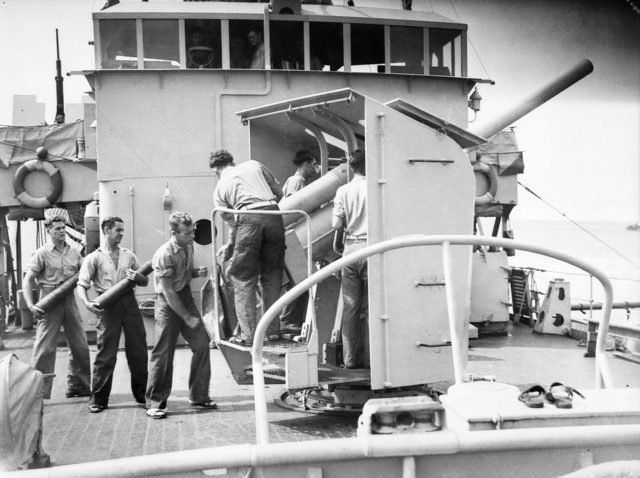
The Type 16 had a twin 4 inch gun on a Mounting Mark XIX was carried aft, controlled by the MRS-1 Close Range Blind-Fire director (CRBF).
Initially this was a 1938 low-velocity 40-calibre naval gun used to arm small warships such as Bathurst and Castle-class corvette ot River-class frigate, upgraded
compared to the Mark IX with a 35 pounds (16 kg) shell and a high-angle mounting giving some anti-aircraft capability or to fire starshells and illuminate a target at night (in WW2 a surfaced U-Boote sneeking in). Many of thse guns were now available from discarded WW2 legacy frigates and corvettes. They used an horizontal sliding-block to elevate -10° to +60° and fired that HE shell to a Muzzle velocity of 396 metres per second (1,300 ft/s) up to 8,870 metres (9,700 yd) at +40°.
Twin 40mm Bofors Mk.5
Behind the bridge was fitted a twin 40 mm Bofors gun on a “utility” Mounting Mark V. These were shielded mounts with relatively tall shield, much more than WW2 equivalents. The Bofors was still an efficient beast of burden of early AA protection, capable of a range of 7,160 m (23,490 ft), 120 round/min at high elevation angles (fed by clips) at a muzzle velocity of 850–880 m/s (2,800–2,900 ft/s).
In their later peacetime service these frigates ended as seagoing training ships, so their 40 mm guns were removed and in their place a large open bridge was added above the rounded face of the existing bridge.
Squid ASWRL
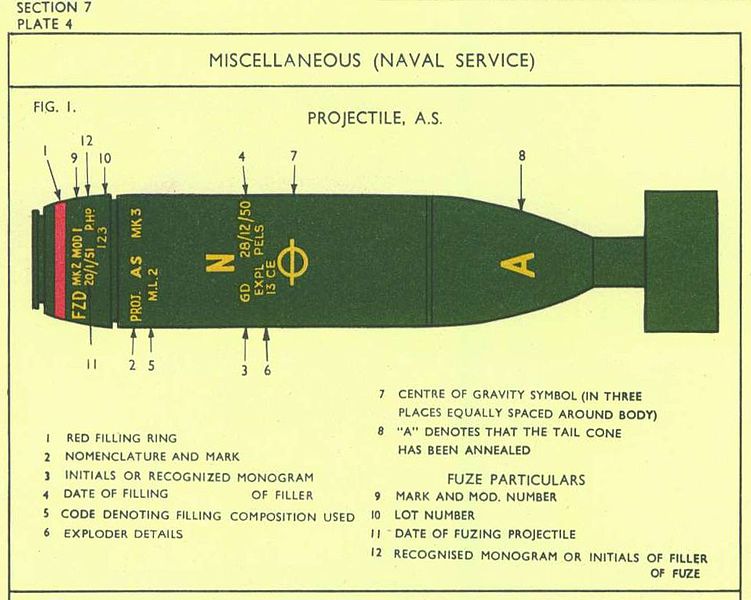
The SQUID MORTAR/BOMB – Mk IV was a British Late World War II ship-mounted anti-submarine mortar composed of three tubes with limited elevation, launching automatically preset depth charges, replacing the Hedgehog. The Tobruk class had it installed on the starboard aft quarter. It was still present on HMAS Anzac in 1968 and at the end of her service, despite the fact it had been long replaced by the Limbo back in UK.
In brief, the Squid launched 390 pounds (177 kg) DCs topped with a 207-pound (94 kg) minol charge which had a sink rate of 43.5 ft/s (13.3 m/s), clockwork time fuse with last moment updates and max depth of 900 feet (270 m), creating a triangle pattern c40 yards (37 m) wide, 275 yards (251 m) ahead of the ship.
Limbo Mark 10 ASWRL
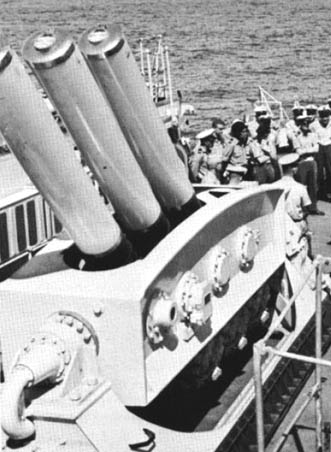 These Type 15 Frigates’s anti-submarine armament was limited to a pair of Mark 10 Limbo anti-submarine mortars when first designed. The system succeeded to the wartime Squid, being mounted on a lower quarterdeck aft to be protected from the weather and remotelly operated, with a 360° field of fire and automatic operation. Unfortunately, a lot of Type 15 Frigates for budgetary reasons were not equipped wit the Limbo and had instead surplus Squid systems, diminishing their ASW potential.
These Type 15 Frigates’s anti-submarine armament was limited to a pair of Mark 10 Limbo anti-submarine mortars when first designed. The system succeeded to the wartime Squid, being mounted on a lower quarterdeck aft to be protected from the weather and remotelly operated, with a 360° field of fire and automatic operation. Unfortunately, a lot of Type 15 Frigates for budgetary reasons were not equipped wit the Limbo and had instead surplus Squid systems, diminishing their ASW potential.
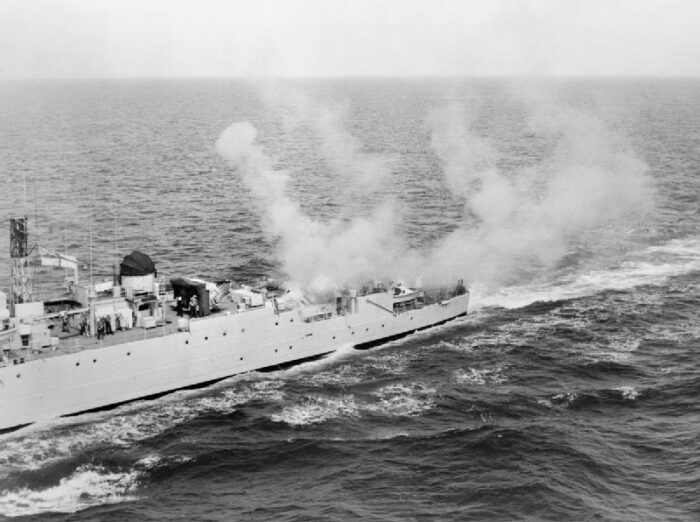
HMS Greenville firing her Limbo mortar in the 1950s
The Limbo was a set of three mortars placed on a tilting and elevating mount in order to rotate to the desire direction, firing a 400 lb depth charge of 12 inches (30 cm) with an effective firing range of 400 yards (366 m) to 1,000 yards (914 m) and carrying a 94 kilograms (207 lb) Minol warhead, using proximity and/or time fuse. It was dependent of the Type 170 sonar to determine with precision the position of the submarine. The three grenades fell in a triangle pattern around the target and sunk to the desired depth before detonating. The bearing and speed of the target was taken in calculations.
The firing was controlled by the Type 170 attack sonar from the Sonar Control Room (SCR) located next to the operations room with three operators maintaining sonar contact with the target, aiming the weapon in bearing, range and depth and firing it by a pistol grip and trigger mounted to the deckhead, that could be electrically cabled and remotelly operated if needed.
Assertion and limitations
They had no helicopter nor ASW torpedoes, not even standard depht charge tracks and throwers so by 1970 they were recoignises as hopelessely obsolete. But they fulfilled their mission as fast interim ASW escorts for a fraction of the cost of building a new ASW frigate. By 1965 there were enough modern ASW Frigates in British service to decommission these 1940s vessels, now all reaching 30+ years or useful career.
Sensors
Type 293Q target indication Radar: Outfit ANS, PP 500kw, Frq 2,997 Mhz, Wlgt 100mm (1945).
Type 277Q surface search Radar: CV56 magnetrons/70 kW, new waveguide system (1942).
Type 974 navigation Radar: X-Band, FRQ 9 405 MHz, PRF 1000 Hz, pwt 0.14/0.26 µs, bwt 1.6°, 24 rpm, PP 7 kW range 25 NM (≙ 46 km) at 2% accuracy.
Type 262 fire control on director CRBF: Centimetric FC set for 40 mm Bofors, fitted to Close Range Blind Fire (CRBF) director and STAAG weapon mount. Dish antenna spun off-centre at high speed to produce scanning cone, target lock and blind fire possible.
Type 1010 Cossor Mark 10 IFF: Friend of Foe identification L-band antenna, interrogates one modes 1,2,3/A a transponder.
Type 174 search Sonar: Narrow beam attack sonar usually associated with Mortar MK 10.
Type 162 Cockwhafer target classification sonar: Side-looking and bottom-scanning shipboard sonar.
Type 170 attack sonar: Hull-mounted, high-frequency “searchlight” sonar with a range of 8,200 feet (2,500 meters).
Air Group
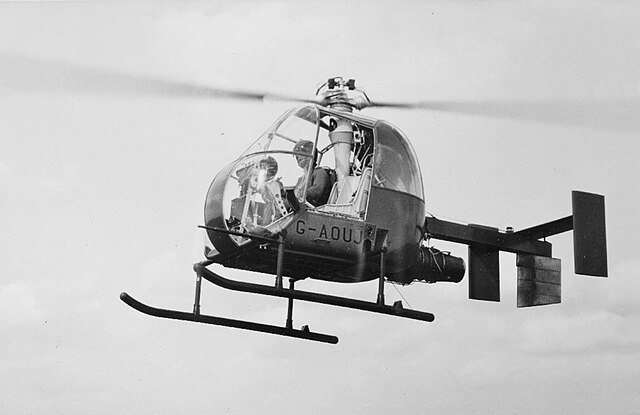
Undaunted was built with a flight deck aft, and was used for trials of the Fairey Ultra-light and Saunders Roe P531 helicopters. Undaunted became the first frigate to carry and operate a helicopter. Grenville had a flight deck fitted in 1959, but this was later removed.

Conway’s depiction of the Type 15 as completed 1952-54
⚙ Type 15 specifications |
|
| Displacement | 2,300 long tons standard, 2,700 long tons full load |
| Dimensions | 358 ft x 37 ft 9 in x 14 ft 6 in (109 x 11.51 x 4.42 m) |
| Propulsion | 2× steam turbines, 2x Admiralty 3-drum boilers: 40,000 shp (30 MW) |
| Speed | 31 knots (57 km/h; 36 mph) |
| Range | |
| Armament | 1×2 4 in (102 mm) Mark 19, 1×2 40mm Bofors Mk.5, 2× Squid/Limbo Mark 10 ASWRL |
| Sensors | Type 293Q TI, Type 277Q SS, Type 974 NR, Type 262 director CRBF, Type 1010 Cossor Mark 10 IFF, sonar Type 174/162/170 |
| Air Group | 1 Whirlwind helicopter* |
| Crew | 174 |
*Plus flight deck on Grenville and Undaunted
Career of the Type 15 class
 HMS Rapid (F138)
HMS Rapid (F138)
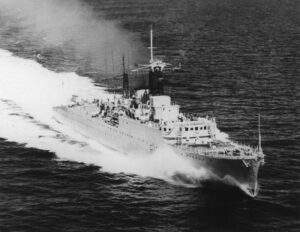 HMS Rapid was converted at Alex Stephens & Sons of Glasgow in 1952–1953. Between 1954 and 1965: Reserve Fleet, but part of ‘Navy Days’ in Portsmouth 1959. On 6 July 1971 she raced against HMS Cavalier but lost after a safety valve blew. In 1965 she was on the disposal list. In 1966 shore establishment Caledonia, sea training of engine room artificers. Replaced by Eastbourne in 1973, target ship, damaged by missiles from HMS Bristol in 1976. Then in Milford Haven. Disposal list in 1978, sunk in the Western Approaches by torpedoes from sub HMS Onyx 1981.
HMS Rapid was converted at Alex Stephens & Sons of Glasgow in 1952–1953. Between 1954 and 1965: Reserve Fleet, but part of ‘Navy Days’ in Portsmouth 1959. On 6 July 1971 she raced against HMS Cavalier but lost after a safety valve blew. In 1965 she was on the disposal list. In 1966 shore establishment Caledonia, sea training of engine room artificers. Replaced by Eastbourne in 1973, target ship, damaged by missiles from HMS Bristol in 1976. Then in Milford Haven. Disposal list in 1978, sunk in the Western Approaches by torpedoes from sub HMS Onyx 1981.
 HMS Relentless (F185)
HMS Relentless (F185)
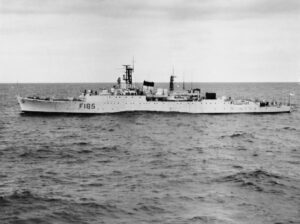 HMS Relentless was laid converted at Royal Dockyard, Portsmouth in 1949–1951. In 1951–1952 she became leader of the 3rd Training Squadron and a year later was in the Fleet Review for the Coronation of Queen Elizabeth II. In 1954 she collided with HMS Vigilant. From October 1956 until 1964 she was in reserve at Gareloch, Chatham and Rosyth. On 27 June 1964 she was re-commissioned with the 29th Escort Squadron to replace HMS Diana. On the disposal list in August 1965 she was sold to to Thos. W. Ward, scrapped at Inverkeithing in 1971.
HMS Relentless was laid converted at Royal Dockyard, Portsmouth in 1949–1951. In 1951–1952 she became leader of the 3rd Training Squadron and a year later was in the Fleet Review for the Coronation of Queen Elizabeth II. In 1954 she collided with HMS Vigilant. From October 1956 until 1964 she was in reserve at Gareloch, Chatham and Rosyth. On 27 June 1964 she was re-commissioned with the 29th Escort Squadron to replace HMS Diana. On the disposal list in August 1965 she was sold to to Thos. W. Ward, scrapped at Inverkeithing in 1971.
 HMS Rocket (F193)
HMS Rocket (F193)
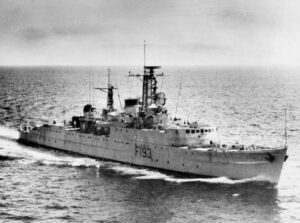 HMS Rocket (F193) was converted at Royal Dockyard, Devonport in 1949–1951. 3rd Training Squadron, Derry, 1953 Fleet Review (QE II Coronation) but she was sabotaged in September 1953 (port Telemotor, steering gear) by a stoker later sentenced to 4 years imprisonment and dismissal with disgrace. In 1954 reserve at Rosyth, re-commissioned 1955. November 1956 reserve at Chatham, Portsmouth 1957. 28 October 1960 re-commissioned at Portsmouth, Far East, 6th Frigate Squadron.
HMS Rocket (F193) was converted at Royal Dockyard, Devonport in 1949–1951. 3rd Training Squadron, Derry, 1953 Fleet Review (QE II Coronation) but she was sabotaged in September 1953 (port Telemotor, steering gear) by a stoker later sentenced to 4 years imprisonment and dismissal with disgrace. In 1954 reserve at Rosyth, re-commissioned 1955. November 1956 reserve at Chatham, Portsmouth 1957. 28 October 1960 re-commissioned at Portsmouth, Far East, 6th Frigate Squadron.
Decom. Portsmouth 11 May 1962, scrapped at Dalmuir March 1967.
 HMS Roebuck (F195)
HMS Roebuck (F195)
Roebuck was converted at Royal Dockyard, Devonport in 1952–1953. 5th Frigate Squadron, QE II Fleet Review. 1957, refitted for training dutie, Dartmouth Training Squadron and again in 1959, recom. May 1960, 17th Escort Squadron. Paid-off reserve Plymouth 1962.
 HMS Troubridge (F09)
HMS Troubridge (F09)
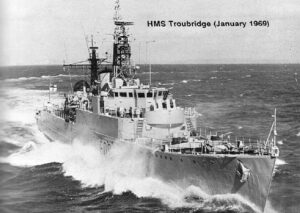 Troubridge was converted at Royal Dockyard, Portsmouth and J. Samuel White in Cowes between 1955 and 1957. 8th Frigate Squadron, America and West Indies Station. In January–February 1958 she took Lord Hailes (Governor-General) a tour. She was in Trinidad for the opening of the Federal Parliament. 21 August 1958 she was in Grenada, sent a detachment to the power station and restore electricity until the strike ended. In 1959: Navy Days in Portsmouth and back to the West Indies.
Troubridge was converted at Royal Dockyard, Portsmouth and J. Samuel White in Cowes between 1955 and 1957. 8th Frigate Squadron, America and West Indies Station. In January–February 1958 she took Lord Hailes (Governor-General) a tour. She was in Trinidad for the opening of the Federal Parliament. 21 August 1958 she was in Grenada, sent a detachment to the power station and restore electricity until the strike ended. In 1959: Navy Days in Portsmouth and back to the West Indies.
29 May 1961 in the Faroe she intervened after the Danish frigate Niels Ebbersen tried to arrest trawler Red Crusader (cod wars). Red Crusader sailed to Britain with the Danish boarding party still on board despite Niels Ebbersen fired warning shot and later solid shorts, damaging the trawler and stayed in pursuit. Troubridge and HMS Wotton arrived on the scene srnt boats for a 4 commanders agreement settling the matter. The international commission later ruled that Niels Ebbersen used excessive force. Late October 1961, Troubridge and Londonderry, Vidal, were in relief operations in Belize after Hurricane Hattie. She was sent in Guiana after rioting in Georgetown on 16 February 1962 sending detachments to patrol the streets and fighting fires.
On 15 May 1963 she started a refit in Malta. Then 27th Escort Squadron, Far East with Galatea, Agincourt and Carysfort. From 8 September 1966 refit at Portsmouth, decommissioned 29 March 1969 at Chatham. Sold 5 May 1970.
 HMS Grenville (F197)
HMS Grenville (F197)
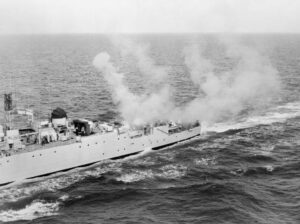 Grenville was converted at Royal Dockyard in Chatham in 1953–1954. 2nd Training Squadron, Portland. 1957: Fitted with an experimental helicopter landing pad for the Fairey Ultra-light Helicopter. December 1958: replaced Torquay in the 5th Frigate Squadron. 1960-1964: Reserve at Gibraltar. June 1966 Portsmouth under tow, fitted with a third mast for experimental air-search radar destined to the Invincible-class aircraft carriers.Portsmouth Navy Days 1967. 1969, replaced Wakeful, 2nd Frigate Squadron. 1970 Portsmouth Navy Days, trials ship for the Admiralty Surface Weapons Establishment (ASWE). Paid off 1974, laid up Portsmouth, scrapped 1983.
Grenville was converted at Royal Dockyard in Chatham in 1953–1954. 2nd Training Squadron, Portland. 1957: Fitted with an experimental helicopter landing pad for the Fairey Ultra-light Helicopter. December 1958: replaced Torquay in the 5th Frigate Squadron. 1960-1964: Reserve at Gibraltar. June 1966 Portsmouth under tow, fitted with a third mast for experimental air-search radar destined to the Invincible-class aircraft carriers.Portsmouth Navy Days 1967. 1969, replaced Wakeful, 2nd Frigate Squadron. 1970 Portsmouth Navy Days, trials ship for the Admiralty Surface Weapons Establishment (ASWE). Paid off 1974, laid up Portsmouth, scrapped 1983.
 HMS Ulster (F83)
HMS Ulster (F83)
Ulster was converted at Royal Dockyard, Chatham in 1953–1956. 8th Frigate Squadron, Iceland, Azores, North America and West Indies Station (Royal Naval Dockyard Bermuda) West Indies and United States. In 1958 she helped to restore power in Nassau, Bahamas. 1964: Reserve in Plymouth. 1965: re-commissioned, 2nd Frigate Squadron. 1967: Withdrawn. 1966 exited dry dock, telegraph failed, full stern collision with the jetty. Heavily damaged stern, replaced by one of HMS Urchin.
Late 1960s, trained naval ratings from HMS Vernon, seagoing training, Sonar Control Room (SCR). 1970: Portsmouth Navy Days, Navigational Training Ship. 1974: Training hulk at HMS Raleigh. 1980: BU by Thos. W. Ward.
 HMS Ulysses (F17)
HMS Ulysses (F17)
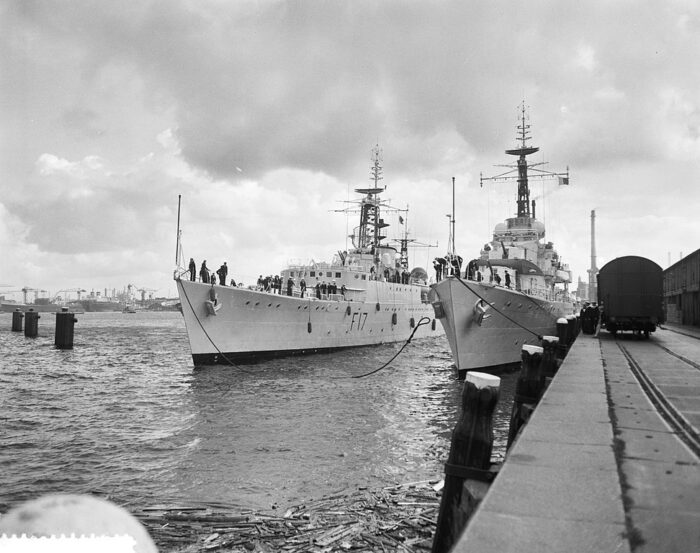
Ulysses was converted at Royal Dockyard, Devonport in 1952–1953. 6th Frigate Squadron, Mediterranean/Home Fleet. Part of the Suez Operation. 1958: Operation Grapple, tests off Christmas Island. 27 October 1958: Collided with HMS Undine off Ushant. 1960: Training ship, Plymouth local squadron. December 1960: Devonport reserve. 1963: Decommissioned. 1963-66 reserve. Accommodation/office space, HMS Danae 1967, BU lymouth 1970.
 HMS Undaunted (F53)
HMS Undaunted (F53)
Undaunted was converted by J. Samuel White, Cowes in 1953–1954. 2nd Training Squadron, Portland, trials of ASW equipment. March 1958: Commission, 6th Frigate Squadron. 1959: Fitted with flight deck, ASW helicopter trials with Saro P.531 and 3x fixed tubes ASW torpedoes, later removed.
April 1960: 20th Frigate squadron, Londonderry, Master of training exercises, demo ship for courses ASW School until 1961. October 1961: refit at Rosyth. 16 February 1962: 2nd Frigate Squadron, Portland, Captain “D”. 1964-1967 Chatham TS refit. 1968 Portsmouth Nav Days. 1969: 5-month refit Chatham. 1973: Reserve. November 1974: Target for HMS Norfolk (D21), Exocet SSM. Damage analysis, repair in Gibraltar. November 1978: HMS Norfolk, Exocet, Seaslug, Seacat, ended by HMS Swiftsure torpedo.
 HMS Undine (F141)
HMS Undine (F141)
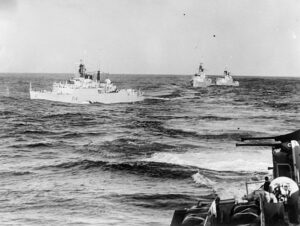 Undine was converted as J. I. Thornycroft in Woolston, Hampshire, 1954. Class I reserve, re-com. 17 August 1954, 6th Frigate Squadron, Mediterranean/Home waters. 26 December 1955-January 1956: 6th FS, anti-smuggling patrols off Cyprus. November 1956: Suez Crisis. July 1957: Refitted at Malta. 27 October 1958 while off Ushant she suffered a loss of power and collided with Ulysses, minor damage, repaired in Devonport. 1958/59: Shelled EOKA’s positions, Cyprus. December 1959, First Cod War, Fisheries Protection Squadron off Iceland until March 1960. April 1960: 6th Frigate Squadron. Paid off 28 October 1960, Disposal List September 1961, solld for BU 12 November 1965.
Undine was converted as J. I. Thornycroft in Woolston, Hampshire, 1954. Class I reserve, re-com. 17 August 1954, 6th Frigate Squadron, Mediterranean/Home waters. 26 December 1955-January 1956: 6th FS, anti-smuggling patrols off Cyprus. November 1956: Suez Crisis. July 1957: Refitted at Malta. 27 October 1958 while off Ushant she suffered a loss of power and collided with Ulysses, minor damage, repaired in Devonport. 1958/59: Shelled EOKA’s positions, Cyprus. December 1959, First Cod War, Fisheries Protection Squadron off Iceland until March 1960. April 1960: 6th Frigate Squadron. Paid off 28 October 1960, Disposal List September 1961, solld for BU 12 November 1965.
 HMS Urania (F08)
HMS Urania (F08)
Urania was converted at Harland & Wolff of Liverpool in 1953–1954. Recommissioned on 2 January 1955 into the 6th Frigate Squadron she was based in the Mediterranean with Ursa, Undine and Ulysses. She took part in the Suez Operation and Cyprus emergency. 1958: Reserve at Devonport, and refit. 7 January 1959 re-commissioned, trials, and reserve 1962-1967, Devonport. January 1967: Operational reserve. Sold for scrap, Faslane 2 February 1971.
 HMS Urchin (F196)
HMS Urchin (F196)
Urchin was converted at Barclay Curle in Glasgow, 1952–1954. Re-commissioned on 3 June 1954, 3rd Training Squadron Londonderry. 1956: Reserve at Portsmouth. 1957: Refitted as training frigate, Dartmouth Training Squadron. Patrolled off Iceland, ‘Cod wars’ 1959. 1964: Decommission, Disposal List. stern structure removed and fitted to Ulster in 1966. August 1967: Towed to Troon, BU.
 HMS Ursa (F200)
HMS Ursa (F200)
Ursa was converted at Palmers Shipbuilding Yard in Jarrow, 1953–1954. 29 June 1955: Re-commissioned at Chatham, 6th Frigate Squadron. November 1955: Mediterranean Station, Sliema Creek, Malta, with Undine, Ulysses and Urania. Boxing Day 1955: Rushed at sea in heavy seas, Ulysses lost crew members overboard, a rescued by a Maltese tug. Performed anti-gunrunning patrols off Cyprus and bombarded EOKA insurgents over periods of 6 weeks. June–July 1956: Minor refit in Gibraltar.
November 1956: Suez Operation, anti-submarine screening, plane guard duties for HMS Albion and Bulwark, protection, tanker force.
April 1957: Decom., Chatham. April 1959 refit, Malta, reserve, resumed 1961, recomm. November, 5th Frigate Squadron. Devonport 27 June. Night 1/2 August 1962: While in ASW exercises, Firth of Clyde, Ursa collided with HMS Battleaxe: Ddamaged bow, repaired but Battleaxe was decommissioned (courts-martial).
March 1963: Ursa relieved Troubridge, 8th Frigate Squadron, West Indies guard ship 1963-1964. Based Bahamas 1966. 28 October paid off Portsmouth, sold for BU 1967.
 HMS Venus (F50)
HMS Venus (F50)
Venus was converted at Royal Dockyard Devonport in 1952–1954. 6th Frigate Squadron. 1953: Fleet Review QE II Coronation. 1955: refitted for Dartmouth Training Squadron. 1964: Reserve. October 1969: Target for the Sea Dart missile system. Sold to Thos. W. Ward for BU 20 December 1972.
 HMS Verulam (F29)
HMS Verulam (F29)
Verulam was converted at Royal Dockyard, Portsmouth in 1952. 1953: Fleet Review, Coronation QE II. 1954: Portsmouth Reserve. 1958-1961 Admiralty Surface Weapons Establishment (ASWE) trials ship. Tested the Type 2001 sonar for nuclear submarines. 1961: Transferred to the 2nd Frigate Squadron, Portland, trials ship, Underwater Weapons Development establishment (AUWE). Paid off 21 December 1970, sold for BU John Cashmore Ltd 23 October 1972.
 HMS Vigilant (F93)
HMS Vigilant (F93)
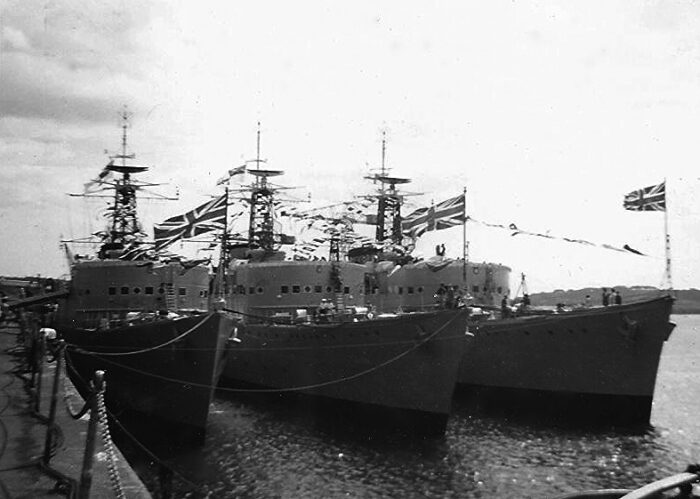
Urchin, Vigilant and Roebuck
Vigilant was converted at J. I. Thornycroft in Woolston, 1951–1952. 6th Frigate Squadron, Home Fleet. October 1954: collided with HMS Relentless, repaired at Devonport. 1955: converted as training frigate, leader, Dartmouth Training Squadron (Vigilant, Venus, Carron, Jewel, Acute). 1963: Paid off sold to Faslane for BU 4 June 1965.
 HMS Virago (F76)
HMS Virago (F76)
Virago was converted at J. Samuel White in Cowes 1951–1952. Re-commissioning 1953, 6th Frigate Squadron, Fleet Review QE II. 1955-1960 reserve at Chatham. 1962-1963 Dartmouth Training Squadron. 1963: reserve at Devonport, decom. Sold for BU Faslane June 1965.
 HMS Volage (F41)
HMS Volage (F41)
Volage was converted at Royal Dockyard in Chatham, 1952–1953. 1954-56: Recommission, Dartmouth Training Squadron. Reserve at Portsmouth until 1964. Used for harbour training, Royal Marines. Never recommissioned, disposal list, sold to BISCO 28 October 1972.
 HMS Wakeful (F159)
HMS Wakeful (F159)
Wakeful was converted at Scotts Shipbuilders in Greenock 1952–1953. 1953: Took part in the coronation Fleet Review. Mediterranean, 5th Frigate Squadron until 1957. 1956: Operation Musketeer (Port Said assault). In 1959: recommissioned as leader, Portsmouth Squadron, training tender, Navigational Training School HMS Dryad. Trials ship, Admiralty Surface Weapons Establishment (ASWE). 25 February 1960: Use for the burial at sea of Edwina Mountbatten, Countess Mountbatten of Burma. 25 August 1960 HMS Apollo collided with Wakeful. Buckled plates.
April 1964: 2nd Frigate Squadron, Navy Days, Portsmouth. Took to shoot the “Bedford Incident”. 1966-1967: Fitted with experimental satellite communication equipment and stabilisers. In 1967 Navy Days Portsmouth, 2nd Frigate Squadron. 31 October 1967: Escorted the RMS Queen Mary to Long Beach. August 1968: Western Fleet Review. June 1969: D-Day commemorations, Ouistreham Canal. 1970: Disposal List. Sold to Thos. W. Ward 10 July 1971.
 HMS Whirlwind (F187)
HMS Whirlwind (F187)
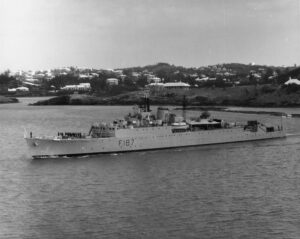 Whirlwind was converted at Palmers Shipbuilding in Jarrow, 1953–1954. Recommissioned 28 July 1953, 5th Frigate Squadron Mediterranean. 1954: Recovery, wreckage de Havilland Comet off Elba. 1956: Suez Crisis. 1957: Cyprus coast operations. June 1959-May 1961: Refit, Rosyth.
Whirlwind was converted at Palmers Shipbuilding in Jarrow, 1953–1954. Recommissioned 28 July 1953, 5th Frigate Squadron Mediterranean. 1954: Recovery, wreckage de Havilland Comet off Elba. 1956: Suez Crisis. 1957: Cyprus coast operations. June 1959-May 1961: Refit, Rosyth.
8th Frigate Squadron, West Indies. December 1962: Bermuda for talks between PM Harold Macmillan and US President John F. Kennedy, Nassau Agreement (Polaris missiles negociations). 1964, with HMS Rothesay, patrolled off Bahamas for illegal traffic from Cuba. 1966: disposal list. 12 August 1969: towed to Pembroke, target but foundered in Cardigan Bay, 29 October 1974.
 HMS Wizard (F72)
HMS Wizard (F72)
Wizard was converted at Royal Dockyard, Devonport, 1954. Trials November 1954, Londonderry, 3rd Training Squadron. October 1955: Retrieved bodies of a crashed Royal Air Force Neptune off Ireland. 1956: 5th Frigate Squadron, Suez Crisis. Back home May 1957, refit Chatham, Dartmouth Training Squadron. 1959: West Indies, 8th Frigate Squadron. 1965: Cadet training, Dartmouth Squadron. 1966: paid-off, Reserve, Disposal, sold to Thos. W. Ward 16 February 1967.
 HMS Wrangler (F157)
HMS Wrangler (F157)
Wrangler was converted at Harland & Wolff of Belfast, 1951–1952. 1953: Fleet Review Coronation QE II. 1953-1955 5th Frigate Squadron, Mediterranean. 1954: Search for wreckage of BOAC de Havilland Comet G-ALYP crashed off Elba. 4 February 1955: Ran aground, Villefranche sur Mer, refloated 6 February 1955 by French Navy and Italian tugs. 1956: Sold to South Africa for £1,425,000. Refitted 1957 in Cardiff at Mount Stuart, commissioned SAN 29 November 1956 as SAS Vrystaat. Saw action off Portuguese Mozambique and 10th Frigate Squadron, Belgian Congo, Congo River. 14 April 1976: sunk as a target by sub SAS Maria van Riebeeck off Cape Point.
 HMS Zest (F102)
HMS Zest (F102)
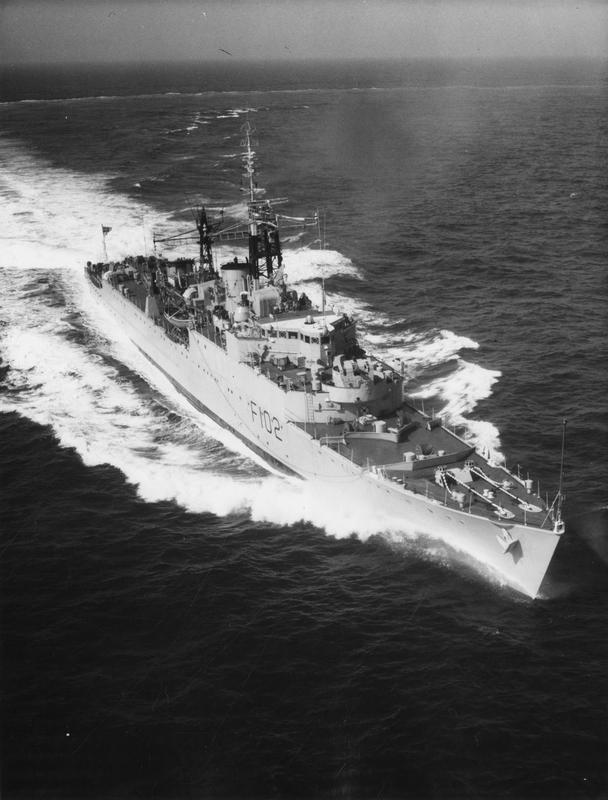
Zest was converted at Royal Dockyard, Chatham in 1954–1956. 1956-1958: Leader, 3rd Training Squadron. 1958-1961: 4th Frigate Squadron. 1961: refit at Malta. 1964: Far East Fleet, 24th Escort Squadron. Patrols in Singapore and Malacca Straits (Indonesian smugglers), Indonesia–Malaysia confrontation. November 1964: assisted merchant ship Pompadour, ran aground, Bombay Shoal, South China Sea. 1965: Back home, paid off Plymouth 15 December, recommissioned 1967, West Indies station. Was of St Vincent in local election. July 1967-July 1968 Far East Station. July 1968: paid off, Reserve Plymouth. 1969: Disposal List, sold to BISCO, Dalmuir 1970.
Read More/Src
Books
Conway’s all the world’s fighting ships 1947-95.
Colledge, J. J.; Wardlow, Ben & Bush, Steve (2020). Ships of the Royal Navy. Barnsley, UK: Seaforth Publishing.
“Royal Navy Frigates 1945-1983” Leo Marriott, Ian Allan, 1983.
Richardson, Ian (August 2021). Osborne, Richard (ed.). “Type 15 Frigates, Part 2: Ship Histories”.
Links
on navypedia.org/
on worldnavalships.com/
on vandwdestroyerassociation.org.uk
on shipsnostalgia.com
en.wikipedia.org/ type_15_frigate
Type_277_radar
Type_293_radar
radartutorial.eu/
radartutorial.eu/
CC photos on commons.wikimedia.org/
on iwm.org.uk
on lewin-of-greenwich-naval-history-forum.co.uk
on navweaps.com guides UK frigates
HD model at rmg.co.uk Greenwhich collections
Model Kits
In 1959 Triang Minic Ships produced 1:1200 metal models (Vigilant, Venus, Virago and Volage) with open and closed bridges between 1959 and 1965.
Frog produced an accurate plastic model kit of HMS Undine at 1:500, with moulds resold to Russia in 1976, re-issued as “Novo” kits. MT Miniatures also produced a 1:700th scale model of HMS Relentless in resin and white metal with photo-etched brass. See it on scalemates.

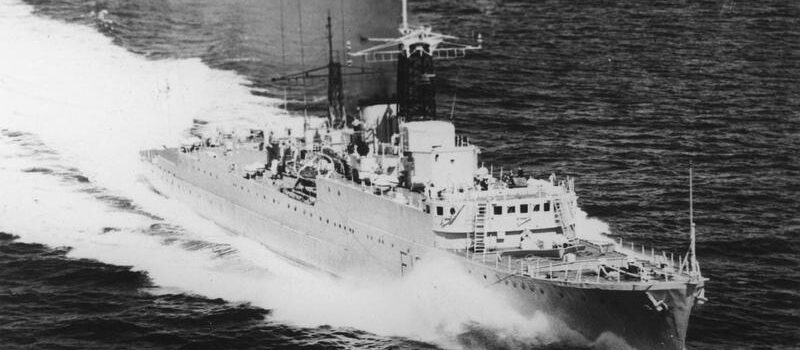
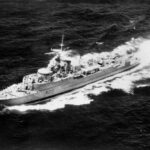
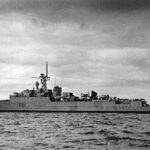
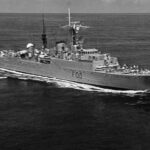
 Latest Facebook Entry -
Latest Facebook Entry -  X(Tweeter) Naval Encyclopedia's deck archive
X(Tweeter) Naval Encyclopedia's deck archive Instagram (@navalencyc)
Instagram (@navalencyc)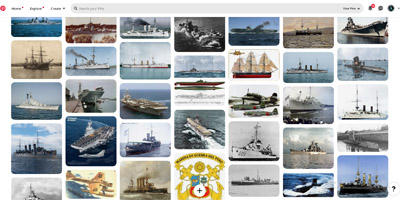

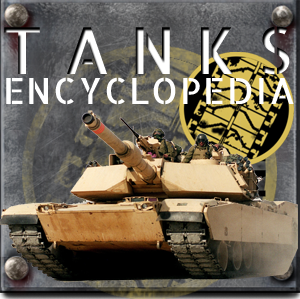
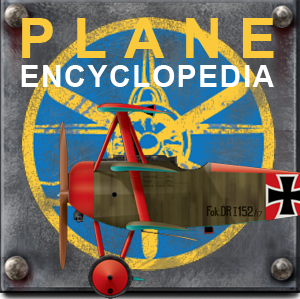
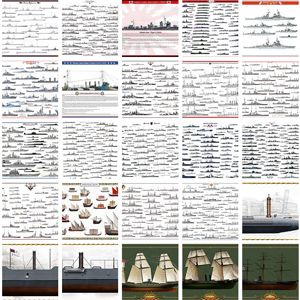
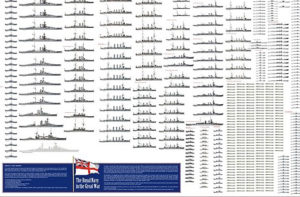
 French Navy
French Navy Royal Navy
Royal Navy Russian Navy
Russian Navy Armada Espanola
Armada Espanola Austrian Navy
Austrian Navy K.u.K. Kriegsmarine
K.u.K. Kriegsmarine Dansk Marine
Dansk Marine Nautiko Hellenon
Nautiko Hellenon Koninklije Marine 1870
Koninklije Marine 1870 Marinha do Brasil
Marinha do Brasil Osmanlı Donanması
Osmanlı Donanması Marina Do Peru
Marina Do Peru Marinha do Portugal
Marinha do Portugal Regia Marina 1870
Regia Marina 1870 Nihhon Kaigun 1870
Nihhon Kaigun 1870 Preußische Marine 1870
Preußische Marine 1870 Russkiy Flot 1870
Russkiy Flot 1870 Svenska marinen
Svenska marinen Søværnet
Søværnet Union Navy
Union Navy Confederate Navy
Confederate Navy Armada de Argentina
Armada de Argentina Imperial Chinese Navy
Imperial Chinese Navy Marinha do Portugal
Marinha do Portugal Mexico
Mexico Kaiserliche Marine
Kaiserliche Marine 1898 US Navy
1898 US Navy Sovietskiy Flot
Sovietskiy Flot Royal Canadian Navy
Royal Canadian Navy Royal Australian Navy
Royal Australian Navy RNZN Fleet
RNZN Fleet Chinese Navy 1937
Chinese Navy 1937 Kriegsmarine
Kriegsmarine Chilean Navy
Chilean Navy Danish Navy
Danish Navy Finnish Navy
Finnish Navy Hellenic Navy
Hellenic Navy Polish Navy
Polish Navy Romanian Navy
Romanian Navy Turkish Navy
Turkish Navy Royal Yugoslav Navy
Royal Yugoslav Navy Royal Thai Navy
Royal Thai Navy Minor Navies
Minor Navies Albania
Albania Austria
Austria Belgium
Belgium Columbia
Columbia Costa Rica
Costa Rica Cuba
Cuba Czechoslovakia
Czechoslovakia Dominican Republic
Dominican Republic Haiti
Haiti Hungary
Hungary Honduras
Honduras Estonia
Estonia Iceland
Iceland Eire
Eire Equador
Equador Iran
Iran Iraq
Iraq Latvia
Latvia Liberia
Liberia Lithuania
Lithuania Mandchukuo
Mandchukuo Morocco
Morocco Nicaragua
Nicaragua Persia
Persia San Salvador
San Salvador Sarawak
Sarawak Uruguay
Uruguay Venezuela
Venezuela Zanzibar
Zanzibar Warsaw Pact Navies
Warsaw Pact Navies Bulgaria
Bulgaria Hungary
Hungary

 Bundesmarine
Bundesmarine Dutch Navy
Dutch Navy Hellenic Navy
Hellenic Navy Marina Militare
Marina Militare Yugoslav Navy
Yugoslav Navy Chinese Navy
Chinese Navy Indian Navy
Indian Navy Indonesian Navy
Indonesian Navy JMSDF
JMSDF North Korean Navy
North Korean Navy Pakistani Navy
Pakistani Navy Philippines Navy
Philippines Navy ROKN
ROKN Rep. of Singapore Navy
Rep. of Singapore Navy Taiwanese Navy
Taiwanese Navy IDF Navy
IDF Navy Saudi Navy
Saudi Navy Royal New Zealand Navy
Royal New Zealand Navy Egyptian Navy
Egyptian Navy South African Navy
South African Navy






























 Ukrainian Navy
Ukrainian Navy dbodesign
dbodesign